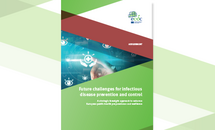Future challenges for infectious disease prevention and control
A strategic foresight approach to enhance European public health preparedness and resilience.
Executive summary
ECDC initiated an elaborate multi-method strategic foresight process in early 2022 to consider and prepare for a broad array of potential future scenarios, in order to improve ECDC’s preparedness and resilience to future threats. This was in recognition of the volatility and complexity of the dynamic systems surrounding public health. By identifying priorities for public health preparedness, research, training and workforce development, the project intends to inform long-term public health planning within ECDC itself, within the EU public health policy arena and by other stakeholders.
The process started by horizon scanning for important global trends relevant for public health (‘megatrends’) and assessing their underlying driving forces (‘drivers of change’). It then interpreted the impact, uncertainties and implications of possible alternative pathways of change towards 2040 (‘driver trajectories’) to develop images of different possible futures from the resulting operational conditions, as well as their associated challenges for infectious disease prevention and control (‘threat scenarios’). Finally, it concluded with imagining what a robust future organisation would look like under such conditions, to assess what actions should be taken in the meantime (‘back-casting’) and stress-testing these actions under the range of plausible operational conditions (windtunnelling). While the conditions in each threat scenario are different, five clusters of common challenges were
identified:
- Climate change persists or worsens in all scenarios. It aggravates infectious diseases through various mechanisms, such as higher risks of vector-borne diseases and zoonotic diseases, higher incidence of food and water borne diseases, and the emergence of novel pathogens, highlighting the importance of One
Health approaches. - Challenges for implementing disease prevention, including vaccination, health communication and other preventative measures would be amplified in the future with lower public trust, higher societal fragmentation, or profit-seeking actors who may deprioritise prevention activities. The proliferation of misinformation further exacerbates these difficulties.
- Demographic shifts, social inequities and reduced access to healthcare may be compounded by increased pressure on existing health systems, cumulatively impacting the conditions in which infectious diseases take root. Ageing populations, people who are socially disadvantaged and people with mental health issues will grow in number, size and diversity.
- Data, digitalisation, and new technologies impact disease surveillance, access to healthcare services, and information ecosystems. Futures in which data quantities continue to increase present unique difficulties, while futures where data becomes less accessible could also create new challenges for disease surveillance
operations. Closely linked to data issues is the emergence of Artificial Intelligence (AI) which could create opportunities and risks for disease prevention and control. - Future changes of governance at global, EU, national and even community level create broad uncertainty for public health. The different directions in which EU governance may develop (e.g. greater fragmentation, harmonisation or unification) could directly impact the existence and relevance of public health authorities, including ECDC.
In preparation for these threats that are shared across the wide range of possible future operational conditions, the foresight process presented here ultimately yielded a collection of robust future-proofed actions for operational, strategic and policy consideration. These actions centre around several strategic focus areas that should:
- Strengthen external communications and outreach capabilities to foster public trust and preserve legitimacy, while developing messaging strategies to relay critical information to a spectrum of communities and groups.
- Further develop data expertise and best practice to ensure preparedness for a breadth of potential data availability and accessibility scenarios.
- Budget for and create working groups and teams in areas like climate change, health economics, behavioural and other social sciences, data modelling, and AI.
- Engage with local populations who are more exposed to the threats outlined in this document vulnerable communities or encourage prioritisation of this type of engagement to build trust, access data, and provide advice that will be more readily received and followed.
- Value international institutional cooperation as a mode of providing mutual assistance to peer organisations (such as WHO and other CDCs), thereby improving European readiness and building responsive action networks in preparation for outbreaks.
Download








